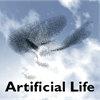大型复杂结构人工开发中的可进化性和末端加法原理。
IF 1.5
4区 计算机科学
Q4 COMPUTER SCIENCE, ARTIFICIAL INTELLIGENCE
引用次数: 0
摘要
表观遗传追踪(ET)是一种发育模型,能够从单细胞开始生成多样、任意、复杂的三维细胞结构。生成结构的复杂程度(就细胞数量而言)可与多细胞生物体相媲美。在这篇文章中,我们研究了受 "法国国旗 "问题启发的一种复杂结构:"意大利阿努比斯"(一种三维的、以三种颜色为图案的狗状图形)的可演化性。发育过程中的基因在特定的发育阶段会在 ET 中被触发,模拟进化过程中个体的适应性会在某个阶段后被计算出来。当这一评估阶段被允许进化时,在发育后期被触发的基因往往会在进化运行的后期被纳入基因组。这表明在该系统中出现了末端加法的特性。当末端添加原则被明确纳入 ET,并成为引入形态创新的唯一机制时,进化性显著提高,从而以更低的计算成本开发出更接近目标的结构。本文章由计算机程序翻译,如有差异,请以英文原文为准。
Evolvability in Artificial Development of Large, Complex Structures and the Principle of Terminal Addition
Epigenetic tracking (ET) is a model of development that is capable of generating diverse, arbitrary, complex three-dimensional cellular structures starting from a single cell. The generated structures have a level of complexity (in terms of the number of cells) comparable to multicellular biological organisms. In this article, we investigate the evolvability of the development of a complex structure inspired by the “French flag” problem: an “Italian Anubis” (a three-dimensional, doglike figure patterned in three colors). Genes during development are triggered in ET at specific developmental stages, and the fitness of individuals during simulated evolution is calculated after a certain stage. When this evaluation stage was allowed to evolve, genes that were triggered at later stages of development tended to be incorporated into the genome later during evolutionary runs. This suggests the emergence of the property of terminal addition in this system. When the principle of terminal addition was explicitly incorporated into ET, and was the sole mechanism for introducing morphological innovation, evolvability improved markedly, leading to the development of structures much more closely approximating the target at a much lower computational cost.
求助全文
通过发布文献求助,成功后即可免费获取论文全文。
去求助
来源期刊

Artificial Life
工程技术-计算机:理论方法
CiteScore
4.70
自引率
7.70%
发文量
38
审稿时长
>12 weeks
期刊介绍:
Artificial Life, launched in the fall of 1993, has become the unifying forum for the exchange of scientific information on the study of artificial systems that exhibit the behavioral characteristics of natural living systems, through the synthesis or simulation using computational (software), robotic (hardware), and/or physicochemical (wetware) means. Each issue features cutting-edge research on artificial life that advances the state-of-the-art of our knowledge about various aspects of living systems such as:
Artificial chemistry and the origins of life
Self-assembly, growth, and development
Self-replication and self-repair
Systems and synthetic biology
Perception, cognition, and behavior
Embodiment and enactivism
Collective behaviors of swarms
Evolutionary and ecological dynamics
Open-endedness and creativity
Social organization and cultural evolution
Societal and technological implications
Philosophy and aesthetics
Applications to biology, medicine, business, education, or entertainment.
 求助内容:
求助内容: 应助结果提醒方式:
应助结果提醒方式:


